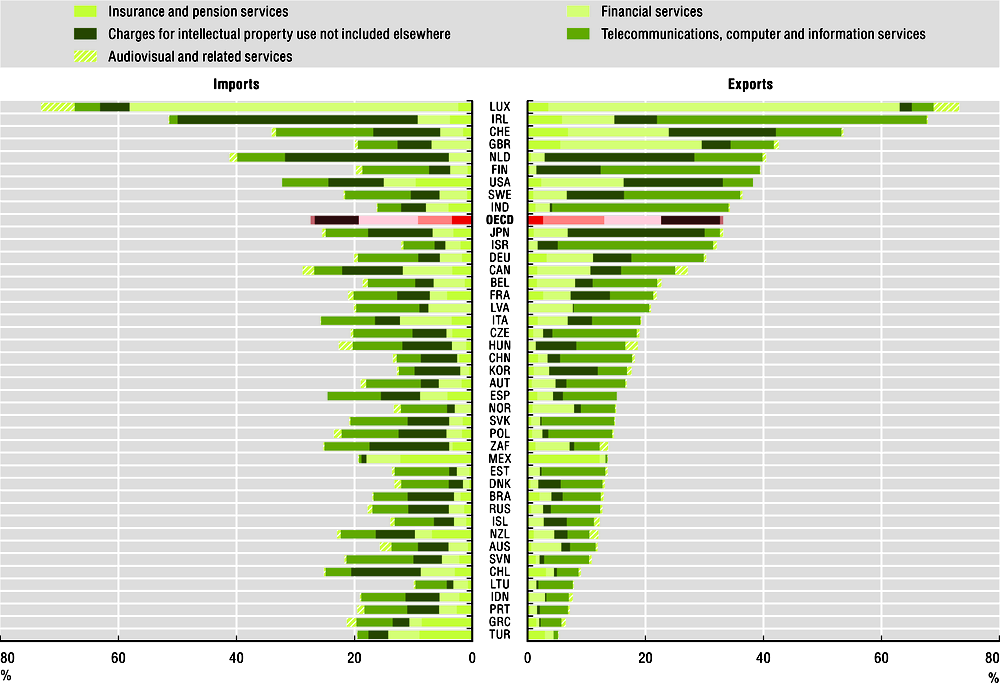9.2. Trade
The digital transformation greatly affects trade. In particular, the Internet has made it easier to buy, sell and deliver certain services, such as telecommunications and audiovisual content, across borders. It has also enabled cross-border electronic delivery of financial, business and knowledge services, such as sales and marketing, management, administration, and back office services, engineering, R&D, and education (UNCTAD, 2015). Furthermore, the Internet has also led to new categories of services, such as web search.
Extended Balance of Payments Services (EBOPS) statistics allow trade in a number of “potentially ICT-enabled services” (UNCTAD, 2015) to be examined. Of these, Telecommunications, computer and information services – which includes many services inextricably linked with digital technologies such as software production and database services – is a key component in many countries, comprising 8% of services imports and 10% of services exports on average in the OECD area.
The Internet, secure networks, synchronised databases and other ICTs are a crucial enabler of financial services trade. Financial services are a particularly key component of services trade in Luxembourg, comprising over half of both services imports and exports, and are also particularly notable exports in the United Kingdom (24% of services exports) and Switzerland (17%).
Charges for the use of intellectual property rights are a particularly notable component of imports in both Ireland and the Netherlands (41% and 28% of services imports, respectively), with the latter having a similar share of intellectual property in services exports (25%). While these payments are often digitally facilitated, the extent to which the contracts granting rights are delivered in digital form is unknown, as is the extent to which the property rights relate to digital properties.
The Internet can facilitate access to global markets, creating new opportunities for consumers and businesses. Key factors affecting the uptake of cross-border e-commerce include IT infrastructure, regulatory frameworks and economic integration. In 2018, 45% of enterprises in the EU28 made cross-border e-commerce sales. Of these, 43% made sales to customers in other EU countries and 26% made sales to customers outside the European Union. The proportion of cross-border sellers to other EU countries was highest in Austria (67%) and Luxembourg (64%). Greece and Ireland had the highest shares of sellers to customers in non-EU countries (almost 40%). Meanwhile, Sweden stands out because 15% of firms there make cross-border e-commerce sales to customers outside the EU only; this share is 5% or lower in other countries and 1.5% on average.
In 2018, 43% of EU businesses selling online made cross-border sales to customers in other EU countries and 26% made sales to non-EU customers.
Definitions
Telecommunications, computer and information services (EBOPS SI1-3) covers the transmission or broadcast of sound, images, data, etc. by telephone, radio, television, email, etc. and other means. Installation services for network equipment are excluded. Sales of customised and non-customised software and related licences are also included, as well as other services such as hardware and software consultancy, implementation, installation, maintenance, and repair, web page development and hosting, systems maintenance and supporting training. Predominantly digital services such as news agency services, database design and delivery services, and web search portals are covered.
Audiovisual services (EBOPS SK1) include the production of film, radio, television and musical content, which these days are usually stored and transmitted in digital form. Live performances are excluded but recordings are included.
Charges for the use of intellectual property include franchises and trademark licensing fees, licenses to use the outcomes of research and development, and licenses to reproduce software, audiovisual, and other products.
An e-commerce transaction describes the sale or purchase of goods or services conducted over computer networks by methods specifically designed for the purpose of receiving or placing orders (OECD, 2011). For individuals, whether sellers or purchasers, such transactions typically occur over the Internet. For enterprises, e-commerce sales include all transactions carried out over webpages, extranet or Electronic Data Interchange (EDI) systems.
Measurability
Imports and exports of “predominantly digitally deliverable services” are measured through business surveys in the context of compiling Balance of Payments statistics. EBOPS provide additional details on the products traded, however digitally delivered services are not routinely isolated so it is necessary to focus on the products that are most clearly digitalised.
Cross-border e-commerce transactions are captured in some countries’ ICT usage surveys. Methodological variations affect comparability including the adoption of different practices for data collection and estimations. See page 4.7 for more information on e-commerce measurement.


